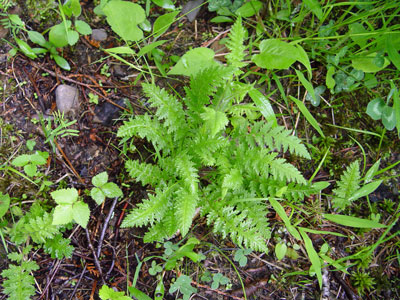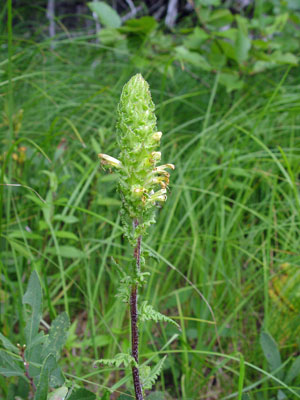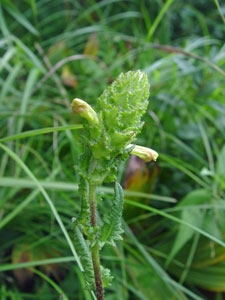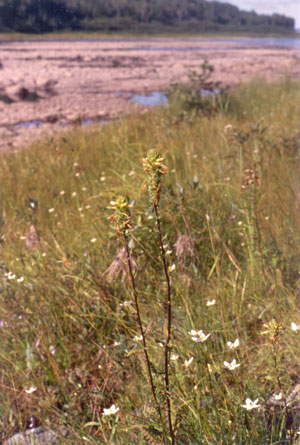DACF Home → Bureaus & Programs → Maine Natural Areas Program → Communities, Plants, and Animals → Rare Plants → Pedicularis furbishiae

Pedicularis furbishiae S. Wats.
Furbish's Lousewort
- State Rank: S1S2
- Global Rank: G1G2
- State Status: Endangered
Habitat: Shrub- or herb-dominated seepy circumneutral riverbanks, between the forest edge and the summer water level; St. John River. [Non-tidal rivershore (non-forested, seasonally wet)]

Range: Banks of the St. John River in Maine and New Brunswick.
Aids to Identification: Furbish's lousewort is unique among louseworts because of its yellow flower with a 5-lobed calyx. It has fern-like leaves, occuring in a basal rosette and continuing up the stem. In flower, it produces a stem 40-100 cm high with 1 or more cylindrical racemes of tubular yellow flowers, each flora about 1 cm long. The racemes elongate as the flowers develop into fruits.
Ecological characteristics: This plant, endemic to the banks of the St. John River, has very specific habitat requirements. It grows on a narrow strip of sloped riverbank which is damp, yet not too close to the water and close enough to the forest to benefit from the shade. It is found in mixed shrub and herb associations with some common roadside asters and clovers, as well as rare species, such as Mistassini primrose (Primula mistassinica), glaucous rattlesnake root (Nabalus racemosus), and Huron tansy (Tanacetum bipinnatum). The open habitat required of Furbish's lousewort is maintained by the yearly scouring of the ice. Like all louseworts, the plant is hemiparasitic, requiring connection to a host plant through haustoria on the roots.

Phenology: Flowers mid-July - August.
Family: Orobanchaceae
Synonyms: None noted.
Known Distribution in Maine: This rare plant has been documented from a total of 13 town(s) in the following county(ies): Aroostook.

Reason(s) for rarity: Endemic species with a naturally small range. Its range is being further depleted by pollution along the lower St. John River.
Conservation considerations: Maintaining a forested buffer at the top of the riverbank is crucial to the persistence of this plant. Some populations have declined after trees at the top of the bank were removed for a view; at others, the original narrow buffer between the river and farm fields has eroded away. The St. John River Resource Protection Plan, which applies to the upriver part of the habitat, includes standards for forestry adjacent to lousewort habitat; assuring that those practices are always followed is important. Some populations could be harmed if all-terrain vehicle use of the rivershore habitat increases.
For more information on Pedicularis furbishiae, see the MNAP Rare Plant Publications page for the following:
A Landowner's Guide to Conservation of Furbish's Lousewort and the St. John River (Printer Friendly Version-pdf-2.4 MB)
Brochure for Furbish's Lousewort (English pdf-1.8 MB, pdf en français-2 MB).